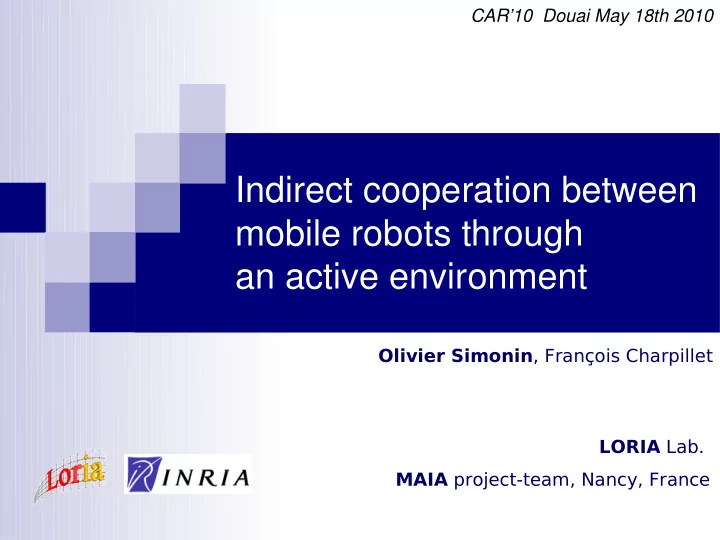

CAR’10 Douai May 18th 2010 Indirect cooperation between mobile robots through an active environment Olivier Simonin , François Charpillet LORIA Lab. MAIA project-team, Nancy, France
Outline 1. Indirect cooperation 2. i-Tiles model 3. Experimentations 4. Conclusion 2
Outline 1. Indirect cooperation 2. i-Tiles model 3. Experimentations 4. Conclusion 3
To abstract the problem.. ? from simulations .. .. to real robots 4
Indirect communication via the environment write Agent behavior Environment behavior read state state action perception local perceptions cells + local operations and actions Indirect communication 5
How to define real active environments which can compute • pheromone marking/diffusion/evaporation • message/signal diffusion → amorphous computing and where robots can • read/write information • interact with many others ? 6
Existing approaches Wireless networks/sensors [Mamei-Zambonelli 06] : augmented environment RFID tags : passive environment [Kodaka09, Park09] Displaying images on the ground and robots • Video projector : passive environment → hard to tune, noisy • [Wanabe06] [Theraulaz07] 7
Outline 1. Indirect cooperation 2. i-Tiles model 3. Application and Evaluation 4. Conclusion 8
Paving the floor with communicating tiles • Provide a regular communicating structure and a memory → allow to implement grid-based algorithms , → allow indirect communication between robots . • Deployed in indoor environments 9
i-Tile : general features Each tile • executes an autonomous process uses a limited memory is connected to its 4-neighbourings tiles supports and interacts with one robot at once Hypotheses on the mesh • tiles are independent processes, • tiles do not require to be synchronized . 10
Tile main process While true If request R in queue Then Switch descriptor of R : Case descriptor_1 : instructions A first thread handling Case descriptor_2 : • incoming messages (FIFO queue) // example: for i in {N,S,E,W} → execute non-blocking procedures send message to Tile(i) ... end Switch end If end While A second thread handling While true the activity of the environment Every(delay1) do instructions → (in the tile) diffusion, evaporation, etc. .. end While → Details in [Pepin et al. ICAART'09] 11
Displacement on a tile : concurrent access A robot asks the permission to move on a target tile → it sends a request to its current tile The target tile grants the access to the first received request 12
Outline 1. Indirect cooperation 2. I-Tiles model 3. Experimentations 4. Conclusion 13
Experimental device Khepera III robots • can perceive tiles on floor • no global positionning (nor coordinate information) • no identification Environment • Tiles are represented on the floor • Tiles' processes are emulated 14
Moving on tiles : odometry correction IR sensors used to detect → • Tiles border angle error → • Gradient lateral error 15
Experiment 1 : Digital Pheromone ? Ant-robot reading/writing pheromones, which evaporates, etc. 16
EVAP model in Tiles & Robots [Glad et al. ECAI'08] Robot Tile 17
Experiment : video 18
Experiment 2 : diffusion of messages Message spread(text, nb_hop, [path]) a spread message is recursively diffused : • to its neighbours (except its sender) • until counter nb_hop (radius) reaches 0 (E,S,S,E) a tile propagates a message to its neighbours IF • the message is new AND nb_hop > 0 • the message is known but nb_hop is greater OR the message is too old → nb_hop = 2 0 19
Dynamic path-planning (scenario) 20
Experiment : video
Outline 1. Indirect cooperation 2. I-Tiles model 3. Experimentations 4. Conclusion 22
Conclusion First step towards indirect cooperation between robots • i-Tiles model experimented with autonomous robots • towards amorphous computing in real environments (CA models, digital pheromones,..) A system based on local computation/connexion and using few memory → distributed and recursive algorithms → scalability Perspectives • (New) distributed algorithms for robots' perception and comm. • Analysis of performances • Electronic design of Tiles and tests with mobile robots 23
Applications • Guidage de robots, coopération multi-robots Extension des perceptions, des communications.. • Actimétrie / suivi des personnes (non intrusif) → Capteurs intégrés aux dalles détection des chutes.. Apprentissage des habitudes → CPER INRIA Lorraine « Informatique Située » → INRIA AEN PAL (Personal Assisted Living) 24
Recommend
More recommend